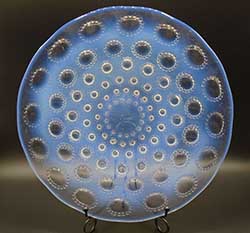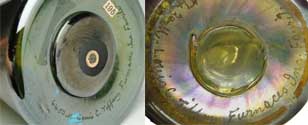Examples and marks of the top 5 collectable glass art makers of the 19th and 20th centuries.

Whether you are a dealer, collector or bargain hunter of antique glass objet d’art it’s easy to get lost when it comes to the various types of glass art, glass makers and glass types to choose from. Knowing what types of glass art are currently popular on the market is also essential if you are looking to find a bargain and make a quick profit. In this antique glass buying guide we can help ensure you don’t buy an unwanted item that has no value or is hard to re-sell.
When buying antique glass from the car boot, an antique shop or fair, or even an emporium that houses multiple dealers together under one roof, make sure you set out armed with some basic knowledge about what to look for. Five famous antique glass art makers that will never let you down, no matter the shape, size, or colour of the glass item you buy. If it has been made by one of the following 5 makers then you are sure to have got a collectable and resalable piece of glass art.
So without further ado let’s look at the top seven antique glass makers to look out for…
1: RENE LALIQUE / LALIQUE GLASS

René Jules Lalique (1860 – 1 May 1945) was a French glass designer known for creating glass art, perfume bottles, vases, jewellery, chandeliers, clocks, and automobile hood ornaments. Rene Lalique gained his experience and skill at the School of Decorative Arts in London and Paris after which he opened his own company in Paris in 1885. When it comes to buying and collecting Lalique glass there are two types to look out for:
- Glass signed ‘Rene Lalique’ or ‘R. Lalique’

- Glass signed ‘Lalique’ or ‘Lalique France’ or ‘Lalique Paris’

Either of the above will be etched into the base of the glass item somewhere and the earlier the object will be in a handwritten style. The best Lalique is ALWAYS the ones signed by ‘Rene Lalique’ or ‘R. Lalique’ as these pieces are early Lalique which is highly sought after and made by Rene Lalique himself or when he was working at the company.
Lalique glass objects made after 1945 usually bear the company name (without the ‘R’ or the ‘Rene’) and have ‘Lalique’ or ‘Lalique France’ or ‘Lalique Paris’ etched to the base of the item. These pieces are still very collectable and can command a very high price depending on the item.
Lalique produced various glass types such as Embossed, Crystal, Opaque, Clear, Frosted and Coloured Glass.
2: EMILE GALLE / GALLE GLASS

Emile Galle born in 1846 and died in 1904 was a French artist and designer who worked in glass and is considered to be one of the major innovators in the French Art Nouveau movement. His exceptional and expressive glass craftsmanship places Galle glass objects amongst some of the most sought-after and collectable glass objet d’art from the 19th and early 20th centuries. After his earth in 1904, the Galle factory continued to produce innovative glass designs based on Emile Galle’s style up until the factory closed in 1936. Galle glassware has an international fan base so if you manage to grab yourself a Galle bargain then you won’t be short of buyers when you come to resell.
When it comes to buying and collecting Galle glass there are two types to look out for:
1: Galle glass signed ‘Galle’, ‘E. Galle’, ‘E, Galle a Nancy’ or glass bearing the paper glued Galle label

2: Galle glass signed ‘Galle’ but with a small star next to the name

The most sought-after Galle pieces of glass art bear the ‘Galle’, ‘E. Galle’, ‘E, Galle a Nancy’ or glass bearing the paper glued Galle labels, as these signify pre-1904 when Galle worked at his factory. Pieces of glass art bearing the ’Galle’ mark but with a star next the name means the item is post-1904 (after Emile Galle died) and was produced at the Galle factor under the direction of Victor Prouvé, a close friend of Emile Galle.
Galle glass maker marks can be raised and etched. The mark is usually horizontal with very occasionally being vertical in format. In addition to glass marking many early Galle glass objects have the paper Galle label glued to the underside of the piece.
3: TIFFANY / LOUIS COMFORT TIFFANY GLASS

Tiffany glass refers to the many and varied types of glass developed and produced from 1878 to 1933 at Tiffany Studios in New York. Tiffany glass was created by Louis Comfort Tiffany who is recognised as one of the most famous stained-glass artists of the United States of the 19th and early 20th centuries. One of the most famous items produced by Tiffany is the ‘Tiffany Lamps’ that incorporate all the stained glass colouring and craftsmanship associated with a world-leading glass art manufacturer. Hint: with real Tiffany lamps, the color pigment is embedded in the glass and won’t rub off with nail varnish.
When it comes to buying and collecting Tiffany glass there are two types of mark to look out for:
1: Louis C. Tiffany, L.C. Tiffany Favrile with Paper Label, L.C. Tiffany Favrile, L.C.T. Favrile Mark

Louis C. Tiffany Furnaces Inc (1920 onwards)

When you search for a piece of glass art by Tiffany check out the mark on the base of the item. Ones with the marks: Louis C. Tiffany, L.C. Tiffany Favrile with Paper Label, L.C. Tiffany Favrile, L.C.T. Favrile are dated around the 1890s. Ones with the ‘Louis C. Tiffany Furnaces Inc’ mark are usually later pieces from 1920 onwards. If you get a choice opt for the Tiffany marks outlined in a) above as these ones will be more sought after.
Tiffany produced a range of glass types such as Drapery, Ring mottle, Ripple, Fracture-streamer, Fracture, Streamer, Favrile and Opalescent glass
4: DAUM GLASS

Daum glass founded in 1878 by Jean Daum in Nancy France is still in operation today as a fine glass art producer. Daum glass is among the top eight antique glass art makers that started in the 19th century along with Lalique and Galle. It is renowned for its Art Deco and Art Nouveau styles and for offering some of the finest glass and crystal decorations. Some of the most valuable Daum to come across would be from Daum’s Farm scene is one of the rarest and most desirable of all decorations.
There are four main types of Daum to collect and they all coincide with each new member of the Daum family working in the business. These four eras are Art Nouveau, Art Deco, Crystal, and Nouveau Pate-de-verre.
When hunting for a Daum glass art object look for the following marks:
1: ‘Daum Nancy’ with the cross of Lorraine (Pre-1927)

2: “Verreries de Belle-Etoile” was signed either “P.d’Avesn” or “Lorrain” or “Val” (company initials), or “Verreries de Belle-Etoile” (Post-1927)

The most sought-after is the ‘Daum Nancy’ marked Tiffany glass as this denotes the early glass art before 1927 and as such usually achieves a higher price. However even Tiffany glass art after 1927 which bears the marks: ‘Verreries de Belle-Etoile’ was signed either ‘P.d’Avesn’ or ‘Lorrain’ or ‘Val’ (company initials), or ‘Verreries de Belle-Etoile’ and points towards the object in question being produced from the Croismare Glassworks near Luneville which Daum took over in 1927.
5: Schneider GLASS

Founded by Charles Schneider and Ernest Schneider in 1913 producing fine art glass. Schneider is among the top collectable glass art manufacturers of the 20th century on par with the likes of Daum, Galle and Lalique. Collectable pieces such as bowls, candlesticks, epergnes, lamps and vases are highly sought after and can command high prices. So if you come across a Schneider piece of glass snap it up straight away. The main characteristics of Schneider Art Glass are the unique designs and unusual use of colour.
When searching for a Schneider glass art object look for the following marks:
a) Charder, Le Verre Francais, Ovington, Schneider, Schneider with France

There are various signature marks to identify Schneider (as above). These marks vary depending on the age of the piece, where, and who has made it. The first mark used by the Verreries Schneider was the candy cane or berlingot mark with bands of red, white and blue enamels. The Schneider script and block letter signatures, either inscribed of acid-etched are the most frequently found.
